Residence of Peter Meyer, Esq.
Carrington Avenue, Mount Victoria (Blue Mountains)
2005 Pipe Organs WA, Bayswater using some parts from a previous Bellsham organ
2m., 12 (13) sp.st., 3c., tr.
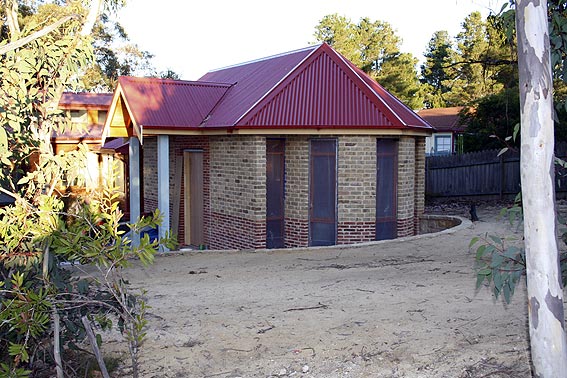
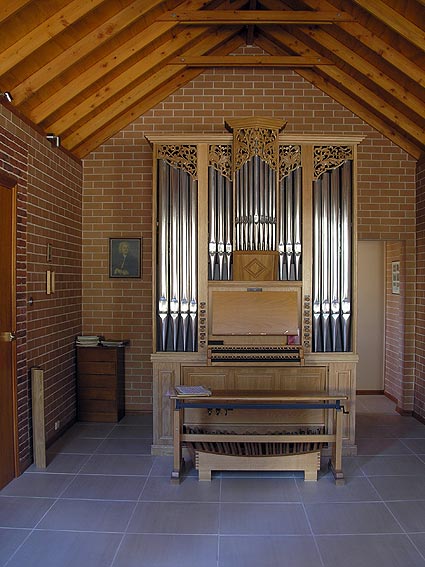
Photo: Simon Colvin (Oct. 2007)
Peter Meyer's home organ in the Blue Mountains is the first made by Pipe Organs of Western Australia to be located beyond Perth. It is Graham Devenish's firm's Opus 6 and follows four continuo instruments and a larger two manual organ for the Anglican Community School at Mirrabooka, Perth. The new organ uses the Stinkens pipes, Heuss console and other parts of a seven-rank instrument made in 1985 by Bellsham Pipe Organs, another Perth-based firm, now defunct. This organ was located in the Callaway Centre of the University of Western Australia. Its specification was (manuals):
| Manual I & II Gedackt Quintade Spitzflote Principal Larigot Krummhorn Pedal Sordun Bass Gedeckt |
8 8 4 2 1-1/3 8 16 8 |
(prepared for) |
The manual stops were playable from either manual, being actuated by Italian-style stop levers with a central "off" position. However, this mechanism did not operate with sufficient precision.
The owner required a new organ with a minimum capacity to give a satisfying, reasonably authentic account of J.S.Bach's "Sei gegrüßet" chorale partita. Thus Graham Devenish added a Nazard/Tierce and Blockflute 2' on the Positive to provide a Cornet Separée. A Principal 4' and Krummhorn 8' were added to the Hauptwerk where the Quintade was converted to a Rohrflute 8' by the addition of chimneys in the canisters, raising the upper lip of the pipes, transposing them up a semitone and revoicing. A Bordun 16' was added to the Pedal. The case, of solid white American oak, was redesigned with a raised central tower and pipe shades carved by Rupert Eachells. The organ is located in a resonant, purpose-built music room by Paul Meyer Design. The final result is an instrument that looks and sounds very beautiful. It provides for the performance of much of the pre-romantic organ repertoire.
From the SOJ Spring 2006, Peter Meyer write:
GENESIS OF A HOME ORGAN - THE NEW PIPE ORGAN IN THE BLUE MOUNTAINS
Like many organists I have wanted a pipe organ in my home for almost as long as I can remember. Yet, when the opportunity arose, I shrank from the decision. It was not so much the cost, although the organ, along with a purpose-built music room, would easily be the most expensive purchase I had ever made. My main concern was that I might end up with an instrument which would be an unsatisfying medium for playing the sort of music that I wanted to play. A gem perhaps, but reduced to the value of an exotic trinket, put away, only occasionally to be taken out and shown off, because it could not satisfy my musical needs.
Can any organ builder really guarantee so nebulous and subjective a notion as the purchaser's satisfaction? I resorted to terminology perhaps most often used in connection with wine. For example I requested “flutes with a fairly warm, rounded tone - a hint of fruit with a touch of honey rather than acid”. I was relieved when the builder replied that these comments were “quite prescriptive”. Presumably he had appreciated what I wanted and was able to comply.
If the purchaser is a committee then a guarantee of complete satisfaction is surely out of the question. What were Arthur Hill's private thoughts, agonies perhaps, about his magnum opus at Sydney Town Hall? On the one hand he had civic fathers on a quest for quantity, on the other a committee of organists in Sydney of whom, individually, he can have had little personal knowledge. Presumably he credited them with some desire for quality. Then there were critics, rivals and experts in England and Europe as well as his firm's reputation. How far could he go in making an organ which, however much it satisfied Sydney's civic pride or delighted colonial ears, might have been ruinous for his reputation everywhere else? Hill told the College of Organists in 1890 that “they wanted something very unusual, and they have got it”.1 Indeed they had, and there would always be critics. Among the first was Thomas Sharp, one of the committee, formerly organist at St John's Launceston, St Philip's Church Hill and, later, All Saints' Woollahra. He thought the organ too big for most Sydney organists.
In my case the builder, Graham Devenish, barely knew me. Naturally, we had a long and detailed correspondence pushing ideas this way and that. Importantly, he came to stay with me at Mount Victoria and we listened to a lot of organ music together. I would say “Ah! That is the sound I want”. (We are listening to Simon Preston playing the Chorale Partitas at Sorø Abbey in Denmark.) Graham would nod, fixing me with a steady gaze and looking very thoughtful. Or was it doubtful?
Adding to the doubts and difficulties was the fact that the organ to be made for me would not be brand new. I could never have afforded it. With the current market price said to be about twenty-five thousand dollars a rank a new organ was out of the question. A New Zealand builder tempted me at sixteen thousand a rank. Even so, I could not afford a six-figure sum. And unless I could have an organ with at least ten ranks I was not going to have one at all. Keith Asboe wisely cautioned that “the trouble with home organs is that you soon get tired of them because what you can play on them is limited”.
Keith was surely right. What exactly did I want to play? I thought very hard about this. Finally I decided that if I was going to have an organ at home then it had to be capable of giving a satisfactory account of J. S. Bach's chorale partita “Sei gegrüsset”. A satisfactory account; not necessarily an authentic account. For I could afford no eight foot principal tone or mixtures. But if I could obtain satisfaction from this chorale with its eleven variations then much else might follow: Bach's short eight preludes and fugues at least, the “Little Organ Book” and much of the repertoire of Bach's English, French and Italian contemporaries and predecessors. I would have plenty to be getting on with. Anything else would be a bonus: some of the Brahms chorale preludes, the Dupré chorales, the odd Mendelssohn movement perhaps. Clearly I would not have the right instrument for Franck and the symphonic literature.
Ten stops. Half of these would comprise a Positiv cornet séparé. In view of the music I wanted to play this was not negotiable. A four-stop Swell - Oboe, Gemshorn, a flute and a string would have been wonderful - but I could not afford both a Swell and a Positiv. How best, then, to accompany the Positiv? I was not so sure but probably principals 4' and 2' above a stopped diapason 8' on the other manual and by 16' and 8' stops on the Pedal. There was some room for flexibility here.
I began looking at redundant organs in journals and on the internet but could find nothing approaching the sort of organ I had in mind. Then, when least expected I found it. During the OHTA conference at Perth in October 2004 Graham Devenish hosted a visit to the works of Pipe Organs Western Australia on an unprepossessing industrial estate at Bayswater. Two or three of his continuo organs were soon in action but most of us were instantly attracted to the large empty case of the organ under construction for the John Septimus Roe Anglican Community School at Mirrabooka, Perth. If nothing else Graham, or someone in his employ, was a superb cabinet-maker. The case of Tasmanian oak was faultless in its attention to detail, a very beautiful piece of work.
In the shadows behind the JSR organ, Cinderella-like, was another, smaller empty case. It seemed to invite no more than a passing glance. What interested me about it were the Italian-style stop levers by which stops could be allocated to either manual. I had not come across these before. The specification was imaginative if not bizarre. It included a Sordun 16', a stop I had never heard of, as well as a Krummhorn 8', a Quintade 8' and a Larigot 1-1/3'. Graham Devenish was in the midst of explaining his plans for the future of this little organ when I asked him to start all over again and he gladly did so. There was no Cornet but the Italian stop levers provided flexibility and a potential I had not previously considered. In fact though, it was the inability of the stop levers to re-align precisely after being moved that rendered this instrument effectively constantly out of tune and therefore useless. Graham proposed to make new windchests on which the pipes of two independent manual divisions and the Pedal organ would stand. He would add a pedal Bordun 16' and a Principal 4' and have a ten rank organ deliverable to any part of Australia for under a hundred thousand dollars.
Here, perhaps, was the organ I was looking for. All sorts of wild imaginings began swarming in my head and I had to make a deliberate effort to remain focused and objective. I turned my back on the forlorn little case and lined up to play the continuo organs. I enjoyed my turn when it came. Pipe Organs WA could make more than beautiful cases.
Cinderella's birth was announced in the OHTA News of October 1988. The announcement was buried beneath news of the four-manual organ under construction for St Patrick's Basilica, Fremantle. Geoffrey Revell of Bellsham Pipe Organs simply announced that he had recently completed chamber organs for the Callaway Centre at the University of Western Australia, the church of the Good Shepherd, Kelmscott, WA and the residence of Mrs L. Blatchford of Pymble, NSW. The empty case in Graham Devenish's organ works belonged to the first of these. The University had bought it at the behest of their English artist-in-residence, Gerald Hendie, who also gave the opening recital on it. It was not often used thereafter. The date on the Bellsham builder's plate was 1985. The specifications of all three instruments were Gedackt 8', Quintade 8', Spitzflote 4', Principal 2', Larigot 1-1/3', Krummhorn 8' for the manuals and Bourdon or Sordun 16' and optional Gedacktbass 8' for the pedals. Wind regulation was by Schwimmer with direct feed from a constant-pressure blower. “The instruments are conetuned”, readers were told though in fact the pipes had tuning slides. Except for the Krummhorn the University's organ had all these stops with a Sordun rather than a Bourdon. Graham Devenish had a Krummhorn in stock which John Larner had purchased from the insurance company which had compensated a church in Castle Hill, NSW, after the theft of this rank. The console, pedalboard, keyboards and coupler chassis had been made by Otto Heuss and there were other parts of good pedigree which it was intended to retain.
My benchmark music required a cornet séparé but how might it be derived from these stops? In my imagination I tried to hear how the Quintade's pronounced third harmonic chip in the initial transients might enable it to do double duty as a Nazard as well as an eight-foot flute. Similarly I speculated about the Larigot substituting for a Tierce. It was hard to think such substitution being remotely satisfactory.
And what about the Sordun? I guessed that it was a reed but could find no reference to it in Sumner. I consulted Pastór de Lasala. His initial instinct was to jettison both Larigot and Sordun and he could see little justification for a Bordun 16' on a home organ either. Norman Johnston queried the usefulness of the Krummhorn while approving the fact that the Positiv would not be enclosed. David Kinsela noted the consequences for authentic performance of the absence of eight-foot principal tone on the Pedal. As seriously as I took all this advice I remained unwilling to discard anything from the hand I had been dealt. I could not afford other stops and, in any case, on such a small organ, every stop would surely count. But would they blend?
After listening to the Quintade and Gedeckt on his voicing machine Graham Devenish decided that the former would serve best if it was converted into a Rohrflute by putting a chimney in the canisters, raising the upper lip and re-voicing. Pastór concurred. In the event it was also found necessary to transpose most of the pipes up a semitone. Graham was able to add a Blockflute 2' and a Nazard-Tierce to the Positiv within budget. Pastór's most helpful suggestion that this latter would be more useful if deployed by a double-draw stop was adopted. (A Nazard can be used alone with an 8' while a Tierce should be used with the Nazard plus 4' and 2' tone.) These, with the Gedeckt and Spitzflute, would make up the Cornet.
Pastór then reminded me that the similar Bellsham originally made for Mrs Blatchford was now in the crypt of St Mary's Cathedral. I decided to suspend the final decision to purchase an organ, its specification and disposition of stops until I had played this instrument on my next trip to Sydney. With Peter Kneeshaw's kind assistance, he, Pastór, Graham Cole, my brother Paul and I duly spent a jolly evening at the cathedral playing all the organs. Graham Cole used the Sordun in a Buxtehude toccata and it sounded fine, providing a clear and musical definition to the bass line. The reverberant acoustics of the crypt mellowed the tone but a Sordun clearly had its uses. It was not the overblown, rasping oriental bazaar screech or wail that I had first feared. I found the stop levers cumbersome but the action was responsive, the organ comfortable to play.
Overall the little Bellsham organ seemed to me to give a satisfactory account of music suited to its concept and limitations. Even so, I hoped mine would be better. Much would depend on Graham Devenish's ability to balance and blend the voicing. His continuo organs gave me assurance that he could though it was not until I had played the Mirrabooka organ on a further trip to Perth that I was certain. I signed the contract for the organ on 1 April 2005.
My attention now shifted to the building of a suitable music room. My first thoughts favoured a circular space. In London I love lingering beneath the great dome of St Paul's during the concluding voluntary. Last time I took two thoroughly secular Muslim computer engineers to Evensong. As Guilmant's “Lift up your heads” moved towards its thunderous climax one of them said to me “It makes you think of God, doesn't it?” His awestruck, wide-eyed girlfriend nodded her concurrence. It does indeed. They had never heard a pipe organ before. What an introduction!
The new music room was designed by my brother's firm, Paul Meyer Design. Paul was not keen on a circle because it could muddy the sound. Neither was Monash University's Professor Robin Alfredson, an acoustic specialist, fellow organist and academic in Malaysia. Robin saved me from the folly of buying a pre-fabricated steel Dutch barn. We settled for cavity brick walls three meters high with a 'cathedral' ceiling lined with pine and a west-facing apse. Internally, smooth-textured bricks and hard ceramic floor tiles over a concrete slab and under-floor heating ensure that the room is acoustically alive and supportive. Tubular stainless steel light fittings complement the polished tin front pipes. The room is entered externally through an impressively tall porch and a massive, solid-core wooden door. I did not have an ecclesiastical- looking building in mind but have to admit that the completed music room does rather resemble one of those tiny, Swiss alpine chapels. I cannot wait to see it under snow. With the organ on only 2.5 inches of wind little sound penetrates the walls. The heavy door is unlikely ever to have to protect me from irate neighbours. In any case, they tell me they are looking forward to some Bach for a change.
They may get him. In Perth the organ was given its first public hearing on 7 April 2006 at a soirée at which Stewart Smith gave one of his immaculately articulated performances of the Short Eight Preludes and Fugues to an audience of fifty. The organ was delivered to Mount Victoria right on time on 26 April 2006. Leigh Collien, Albert Soh and I helped Graham Devenish to re-erect it after its long trip from Perth in a container on The Indian-Pacific. This took less than a week but Graham spent most of a further week tuning and final voicing. He appeared to revel in twelve-hour working days of intense concentration on pitch, timbre and volume. A perfectionist was hard at work. Thanks to its case of solid white American oak and the carved pipeshades of Rupert Eachells the completed organ looks as well as sounds first class. The carving depicts Australian flora with the owner's initials and the crossed keys of St Peter subtly incorporated. Fine craftsmen can deliver complete satisfaction and in this case they surely have. For the record the following details are tabulated below:
Tremulant to Positiv
3 pedal hitchdown couplers: Positive to Hauptwerk,
Hauptwerk to Pedal, Positiv to Pedal.
3 Schwimmer bellows operating butterfly air control valves
Laukhuff “Ventus” blower. 65/75mm wg
Double armed keyboard mechanical action.
Tuned to A=440 equal temperament at 16 degrees Celsius.
Reference
1. Ampt, R., The Sydney Town Hall Organ, 1999, p.15.
Peter Meyer was taught piano by Eric Aubert and from 1956, the organ by George Faunce Allman, his music master at Shore. In 1961 he became a pupil of Norman Johnston. The following year, aged fifteen, he succeeded Will Monk as organist at St Philip's Church Hill where he remained until 1967. Here he re-established the choral tradition. He broadcast several times on the 'Young Australia' program and gave his first Sydney Town Hall recital in 1965. In 1966 Peter Meyer was Organ Scholar at Sydney University and President of the Sydney University Organ Association. In 1973 his career reached a turning point when he declined the late Michael Dudman's invitation to succeed him at Newcastle Cathedral. Instead, he went to St Ignatius College, Riverview where he was senior history master and College organist for several years. There followed a career as a teacher trainer in developing countries of the Commonwealth: Nigeria, Brunei and Vanuatu. For ten years from 1995 Peter Meyer was director of the programs in Malaysia of the University of Technology, Sydney with whom, in Sydney since 2005, he has been Director of Academic and English Language Support.
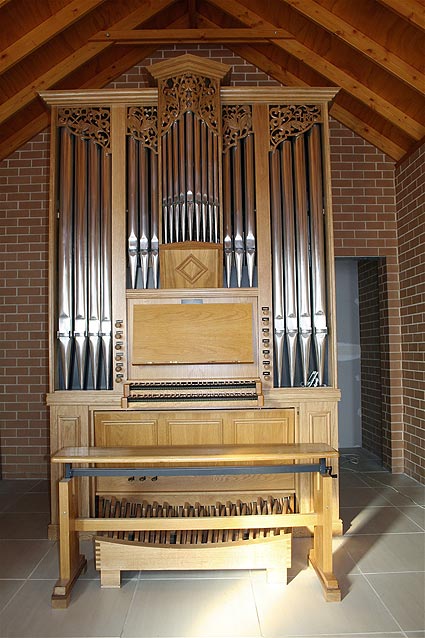
The specification is:
| I - Hauptwerk Rohrflute Principal Principal Krummhorn II - Positiv Gedeckt Spitzflute Blockflute Nazard/Tierce Larigot Tremulant Pedal Bordun Bass Gedackt Sordun Couplers I - Ped II - Ped II - I |
8 4 2 8 8 4 2 I - II 1-1/3 16 8 16 |
Stinkens. 70% tin. Former Quintade Stinkens. Spotted Metal Stinkens. Lowest 7 pipes on display, central tower Unknown. Upper octave Stinkens. Originally 16' Laukhuff. Bottom octave wooden pipes by Bellsham Stinkens. Lowest 5 pipes fully stopped. 25% tin Roger Jones 2-2/3 when half drawn, 1-3/5 added when fully drawn (breaks back at top C#) Roger Jones Stinkens. Top octave Roger Jones (originally Quintleine modified at the mouths to Larigot) Pipe Organs WA Bellsham Laukhuff. Hammered plain metal resonators on copper tubves in hammered metal boots. Hitchdown |
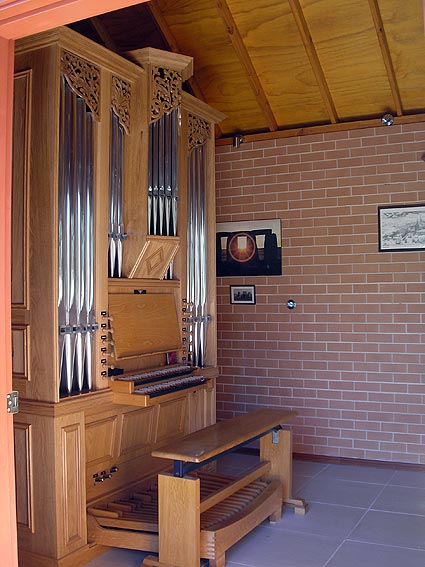
Photo: Simon Colvin (Oct. 2007)
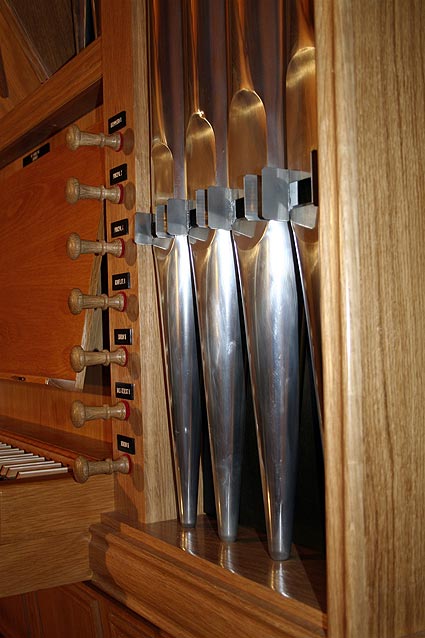
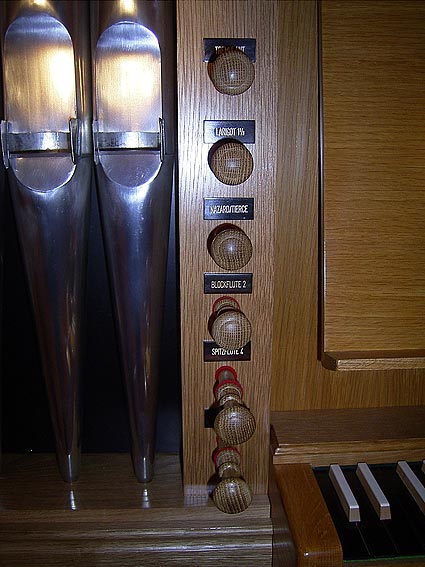 |
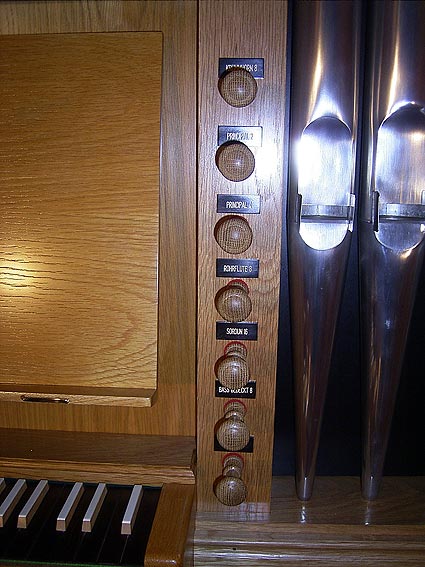 |
|
 |
||
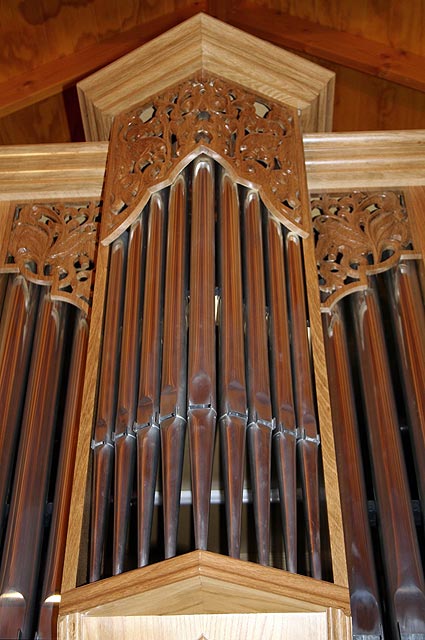 |
||
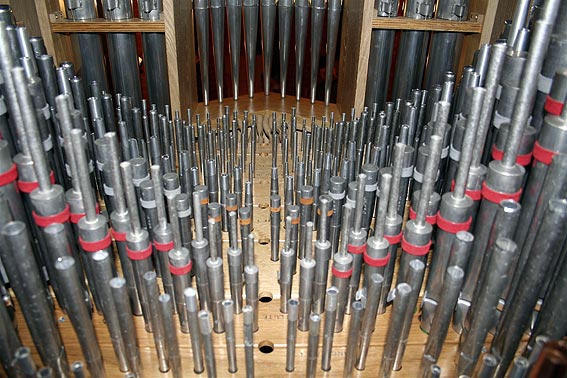 |
||
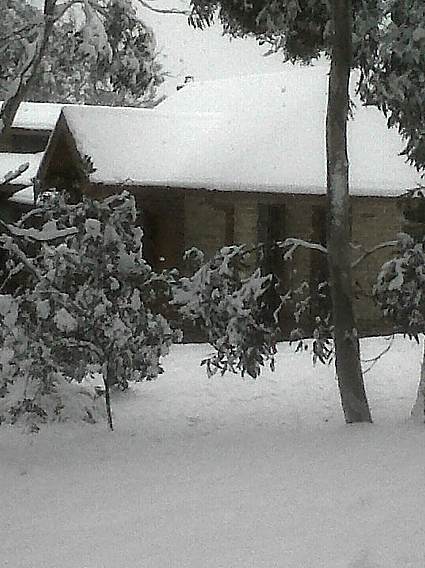
The music room covered in snow in winter 2012 (photo: Peter Meyer)
Specification noted 5th May, 2006 Mark Quarmby
Photos provided by Mark Quarmby and Trevor Bunning
Notes provided by Peter Meyer, 30th May 2006.